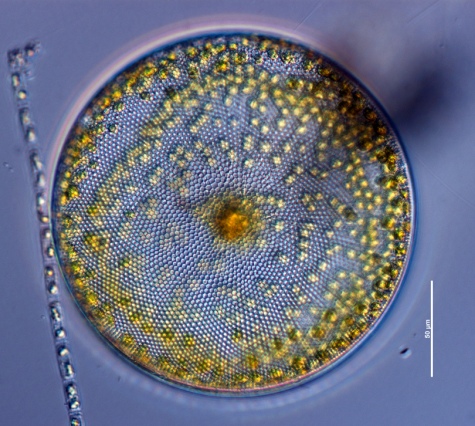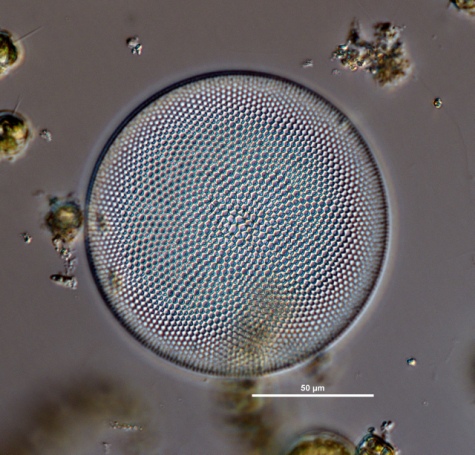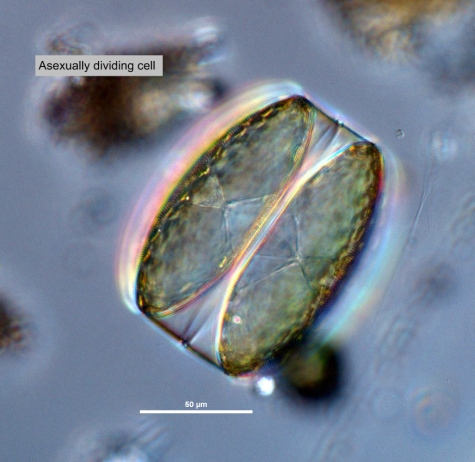



|
Synonym(s)
Heterotypic
A difference in type. In naming species, a heterotypic synonym is one that comes into being when a taxon becomes part of a different taxon. Compare to homotypic.
(heterotypic)Coscinodiscus oculus-iridis var. tenuistriata Grunow 1884 (heterotypic)
(Guiry and Guiry 2011)
Classification
(Guiry and Guiry 2011)
Lifestyle
Description
Areola(e)
In diatoms, the regularly repeated hexagonal holes on the valve walls (HPP 2003).
areolae in a slight depression (Cupp 1943). Chloroplasts are small, numerous, and plate-like (Hasle and Syvertsen 1997). Cells are yellow-brown in colour (Guiry 2011).Margin
The outline or border that defines the shape of an organism or cell.
margin, and 5 - 6 near margin. CloseSpinula
(plural: spinulae) A small spine or hook.
Spinulae along margin 5 - 7 μm apart, placed a short distance in from margin. Three to four rows of areolae between spinulae. Spinulae often difficult to see in CloseValve
In diatoms, the structurally distinct halves of the cell wall (Becker 1996).
valve view. CloseRadial
(symmetry) Describing a shape that many axes of symmetry. That is, it does not have a left and right like humans do (bilateral symmetry), but can be divided into equal halves no matter where you place the axis. Some examples of radially symmetrical organisms include sea stars and centric diatoms like Thalassiosira.
Radial lines from spinulae toward center indistinct. Two asymmetrical CloseApiculus
(plural: apiculi) Short, sharp, but not stiff projections (Kuo 2006).
apiculi, sometimes difficult to see; in some specimens distinct. Two collarlike CloseIntercalary bands
Girdle bands that are furthest away from the valve (Smithsonian 2011).
intercalary bands on each valve, the one nearer the valve broader than the other. Inner chamber openings distinct, outer membrane more or less strongly ClosePoroid
A simple hole through the surface of a diatom valve (Smithsonian 2011).
poroid. Radial rows and secondary curved rows marked. Valve margin radially striated, 6 - 8 CloseStriae
(referring to pores in diatoms) In diatoms, a striation or row of pores on the valve face. "In centric diatoms, striae may be radial, running from the centre of the valve to the margin ... In pennate diatoms, striae may be parallel to the median line of the valve or raphe" (Horner 2002).
striae in 10 μm" (Cupp 1943).Hyaline
Resembling glass; transparent or translucent.
hyaline lines, distinct in weakly CloseSilicic acid
A general term to describe chemical compounds containing silicon, oxygen and hydrogen with a general formula of [SiOx(OH)4-2x]n. Diatoms polymerize silicic acid into biogenic silica to form their frustules (Azam and Chisholm 1976).
silicified valves and indistinct in coarsely silicified valves. CloseDecussating
Intersecting to form an"X" shape.
Decussating arcs in the central part of the valve. Hyaline lines associated with CloseLabiate process
In diatoms, a simple slit in the valve wall with two internal lips, one on each side of the slit. They can be useful in identification because they are positioned differently in different species (Horner 2002).
labiate processes at the valve margin. Interstitial meshes present, identical with the pentagonal areola at the point of origin of an incomplete stria or an adjacent larger areola. CloseCribrum (cribra)
(plural: cribrae) A perforated siliceous plate that blocks one of the many pores in a diatom's frustule (van den Hoek et al. 1995).
Cribra resolved with LM, consisting of one central pore and a marginal rings of pores. CloseMarginal process
In some diatoms, a long, coarse external tube through the frustule (Tomas 1997).
Marginal processes readily resolved with CloseLM
(light microscopy) "Using a microscope in which a beam of light passes through optical lenses to view an image of the specimen" (MCM LTER 2010).
LM; the smaller processes are long necked and slightly curved, and the two larger processes, around 135° apart, have two CloseHorns
The apical or antapical extensions found in some armoured dinoflagellates; they contain cytoplasm, are covered in thecal plates and can be hollow or partially solid (Horner 2002).
'horns'" (Hasle and Syvertsen 1997).Measurements
Diameter: 100 - 300 μm
Valve areolae: 4 - 6 in 10 μm
No. of Close
Theca
(plural: thecae) Cell wall. In dinoflagellates, it is composed of cellulose plates within vesicles (Horner 2002).
bands/theca: 3Close
Valvocopula
In diatoms, a band next to the valve that may help link the valves together (Hasle and Syvertsen 1996).
Valvocopula width: 20 - 24 μmProcess
A natural projection or appendage on an organism.
Processes:Margin rings: 1
Areolae from margin: 3 - 4
Areolae apart: 2 - 5
Scattered on valve face: no
(Hasle and Syvertsen 1997)
Similar species
Harmful effects
Habitat
Distribution
Growth conditions
Environmental Ranges
Temperature range (°C): -1.743 - 24.625
Nitrate (μmol L-1): 0.360 - 18.305
Salinity (PSU): 17.940 - 36.252
Oxygen (mL L-1): 4.344 - 9.192
Phosphate (μmol L-1): 0.074 -1.717
Silicate (μmol L-1): 1.252 - 39.813
(OBIS 2011, cited in EOL 2011)
Bloom characteristics
References
Cupp, E. E. 1943. Marine Plankton Diatoms of the West Coast of North America. University of California Press. Berkeley, California. 238.
Encyclopedia of Life (EOL). 2011. Coscinodiscus centralis. http://eol.org/pages/912745/overview. Accessed 8 Oct 2011.
Guiry, M. D. 2011. Coscinodiscus centralis Ehrenberg, 1844. http://www.marinespecies.org/aphia.php?p=taxdetails&id=149159. Accessed 8 Oct 2011.
Guiry, M. D. and Guiry, G. M. 2011. Coscinodiscus centralis Ehrenberg. http://www.algaebase.org/search/species/detail/?species_id=37676. Accessed 8 Oct 2011.
Hasle, G. R. and Syvertsen, E. E. 1997. Marine diatoms. In: Tomas, C. R. (ed.) Identifying marine Phytoplankton. Academic Press, Inc., San Diego. 5-385.
Horner, R. A. 2002. A Taxonomic Guide To Some Common Phytoplankton. Biopress Limited, Dorset Press, Dorchester, UK. 200.
Ocean Biogeographic Information System (OBIS). 2011. Coscinodiscus centralis. http://www.iobis.org/mapper/?taxon_id=427593. Accessed 8 Oct 2011.
Sanilkumar, M. G., Padmakumar, K. B., Menon, N. R., Joseph, K. J., Sanjeevan, N. and Saramma, A. V. 2009. Algal blooms along the coastal waters of southwest India during 2005-08. Journal of the Marine Biological Association of India. 51(1): 69-74.
